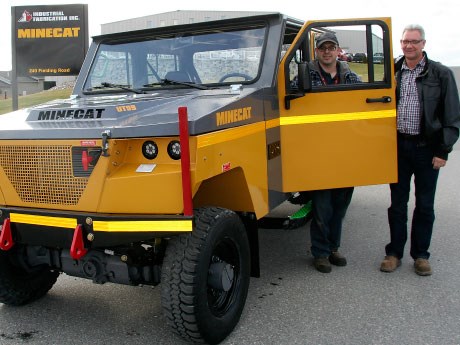Minecat UT150-EMV utility vehicle surpasses 10,000 kilometres of runtime by Vale, Glencore and Goldcorp
Diesel still rules, but the beginning of a transition to battery-powered vehicles in underground mining appears to be underway.
Industrial Fabrication, a Sudbury-based manufacturer of underground utility vehicles, has three Minecat UT150-EMVs in operation – one at Vale’s Creighton Mine, one at Glencore’s Fraser Mine, both in Sudbury, and one at Goldcorp’s Musselwhite Mine 480 kilometres north of Thunder Bay in northwestern Ontario.
The Sudbury manufacturer first looked at battery power in 2004, but backed away because “at that time we felt the technology wasn’t ready for underground,” said Industrial Fabrication vice-president Daryl Rautiainen. By 2011, it was a different story.
The company started off with a data logging exercise using a diesel-powered Minecat UT99 utility vehicle “to collect as much information as possible about the distance travelled per shift, the speed, how much on grade and how much on flat,” said Rautiainen. “That allowed our engineering department to size the battery and drive train.”
Key customers were invited to Industrial Fabrication’s new 34,000-square-foot manufacturing facility to take the prototype for a spin and all were duly impressed.
Arrangements were made for further testing at Vale’s Creighton Mine, where it chalked up 3,700 kilometres over the course of a one-year trial.
“It was very successful,” said sales manager Marcel Demers. “We had a few challenges, but not one breakdown.”
Goldcorp’s Musselwhite Mine has been testing two battery-powered utility vehicles – Industrial Fabrication’s Minecat and the PapaBravo Marmot, manufactured by Prairie Machines & Parts of Saskatoon. The trial is scheduled to continue to year-end, at which point the mine will decide if it’s going to proceed with electric power and, if so, which unit is the better fit.
Between the three vehicles, including the one purchased by Glencore, “we have upwards of 10,000 kilometres of runtime underground… on ramps,” noted Rautiainen.
The standard lithium iron phosphate battery pack in the three existing vehicles allows for between three and four hours of runtime depending on use, said Industrial Fabrication engineering manager Dave Schmidt. “That’s straight driving. The duty cycle underground can be very different if you’re a supervisor or someone going to the face and working, so it’s very application-specific. Based on our data logging and the three trucks so far, the standard battery pack is sufficient. It’s sized for an average shift.”
Beyond the standard battery pack, Industrial Fabrication has several options for additional energy storage.
“We look at the battery like a fuel tank,” said Rautiainen. “We can tailor the battery size to the application, so if we’re into a very severe ramp application, we would scale the pack up.”
Following a shift, during lunch or even during a break, the operator simply plugs the battery in for recharging.
“Our original goal was to be able to plug it in to a jumbo socket,” said Schmidt. “We charge on 600 volts and have an onboard transformer that let’s that happen. Currently, we have charging stations at the different mines. It’s an onboard charger you just plug into the wall. It’s a very simple charging station.”
“We can tailor it to what the mine requirements are,” added Rautiainen. “We call it opportunity charging. It’s getting the customers in that mindset so when they stop for lunch, they plug it in, or between shift changes – any opportunities they have to plug in. We try to make the plug socket as common as possible so they can plug in at different locations throughout the mine. That way, they don’t have to go to one specific area.”
The battery pack should last 10 years. “At that point, it still has 80 per cent of its capacity, so there’s residual value in it,” said Schmidt.
The battery and the electric drive system sit under the hood and mount on the vehicle’s existing motor mounts, leaving the rear of the truck free to accommodate any of Industrial Fabrication’s many configurations.
“We didn’t have to make any changes to the frame and did that on purpose so we could repower our diesel units in the future,” said Schmidt.
The electric vehicles cost about 40 per cent more than a convention diesel-powered vehicle, but for a mine that’s going deeper and has maxed out its current ventilation infrastructure, or wants to create a cleaner, healthier environment for its workforce, conversion to battery power makes a lot of sense.
“Ventilation is a big expense for most mines, especially if they’re going deeper,” said Schmidt.
“There’s a lot less demand on a ventilation system when you go to an all-electric mine. Another driver for battery power is the health benefits because you’re doing away with the diesel emissions, which the World Health Organization has identified as a carcinogen. Maintenance savings are quite significant, too, because there are 1,000 fewer parts in our battery power drive train. There are no fuel filters, no oil filters, and no fuel. All these things add up.”
Most mining companies are watching their pennies given the current downturn in the market, but Industrial Fabrication has its sights set on two or three years down the road when the market turns around.
“We’re getting ready for that turn,” said Demers. “It’s definitely going to happen and companies are asking us to be ready.”
Although the company has to date only applied the battery power system to its UT99 platform, it’s also designed for use with its MC100 and forklift product lines.



